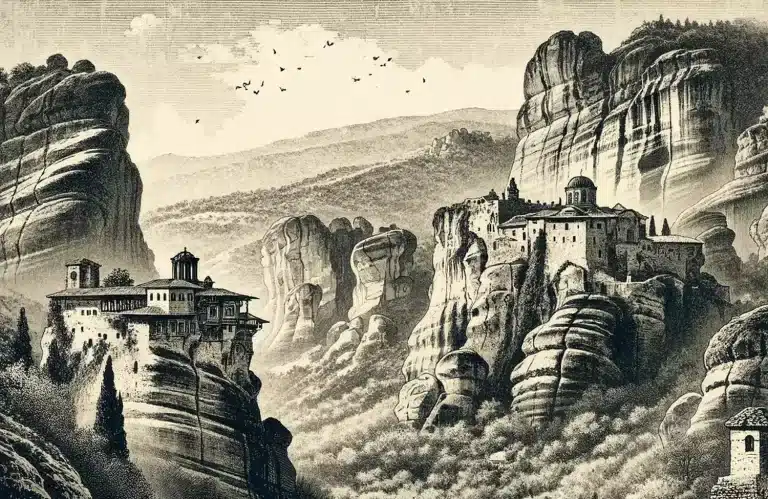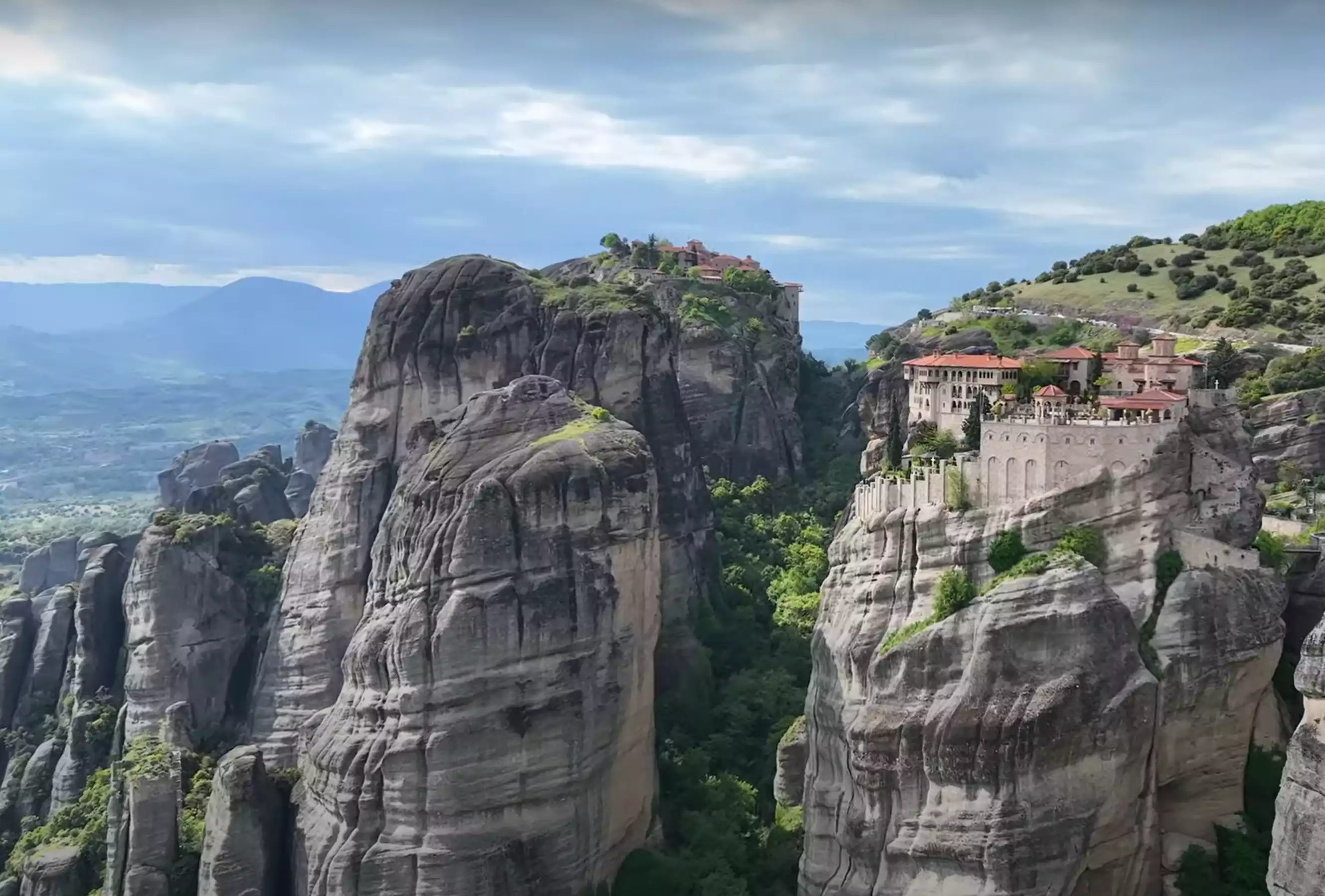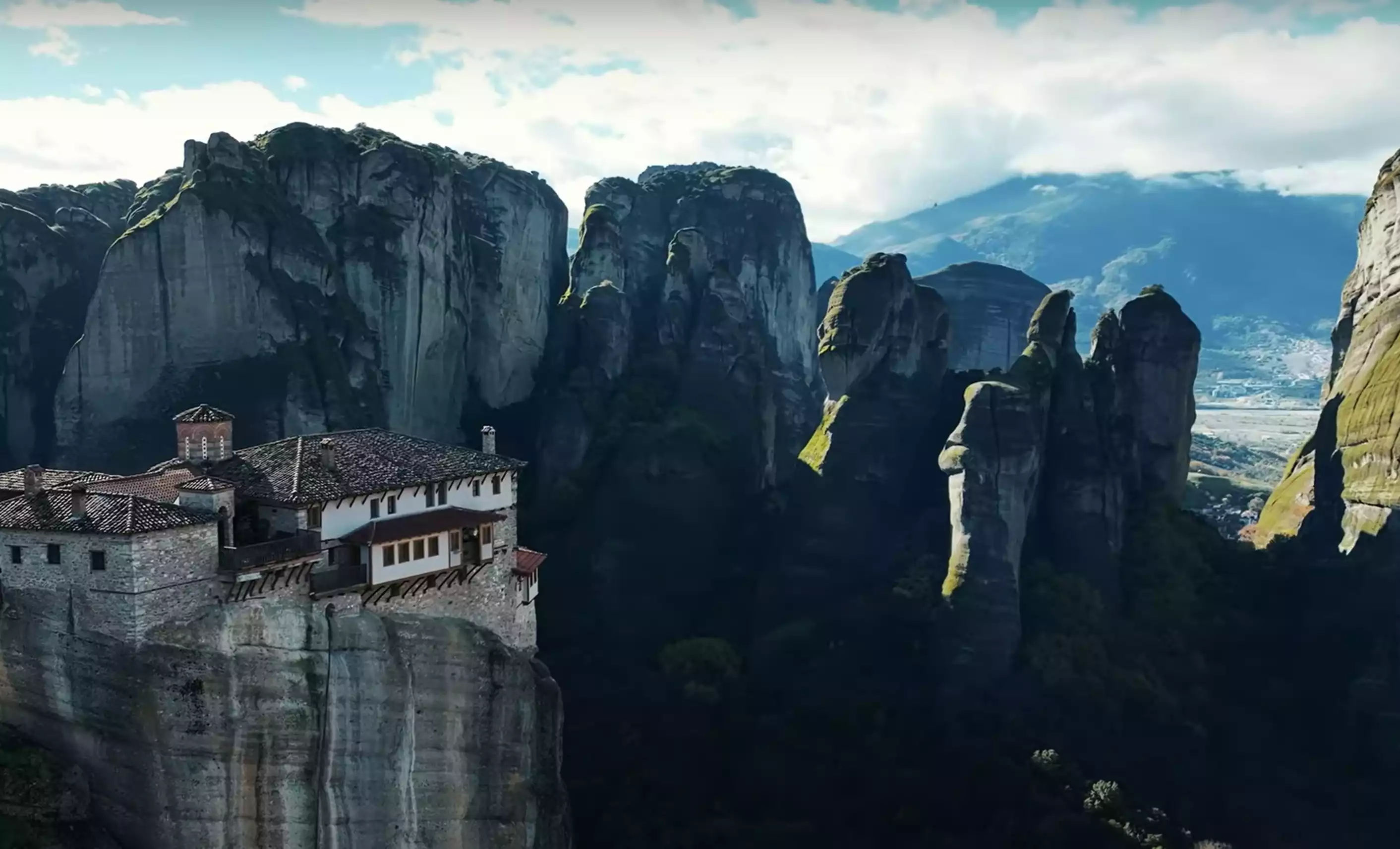
Meteora Monasteries, a word evoking images of towering rock formations crowned by historic monasteries, stands as a testament to human resilience and spiritual devotion. Nestled in central Greece, it is a UNESCO World Heritage site, revered for its historical significance and profound Christian relevance.
Etymological Analysis
The term ‘Meteora’ is derived from the Greek word μετέωρα, meaning ‘suspended in the air’ or ‘in the heavens above.’ This aptly describes the gravity-defying monasteries perched atop these gigantic rock pillars. These monasteries, reaching towards the heavens, serve as a metaphor for the Christian aspiration to ascend spiritually, seeking closeness with the divine.

Historical Emergence of Meteora Monasteries
The origin as a place of asceticism and monasticism dates back to the 9th century. Early hermit monks sought solitude in these heights, laying the groundwork for what would become a monastic community unlike any other in the Christian world. By the 14th century, this area witnessed a significant transformation with the establishment of the Great Meteoron Monastery by Saint Athanasius the Meteorite, a key figure in Meteora’s monastic history.
Athanasius’s arrival at Meteora heralded a new era. He and his followers built the first monasteries atop these rocks, not merely as places of worship but as sanctuaries of learning, art, and culture. This period was marked by the flourishing of Byzantine art, as seen in the exquisite frescoes that adorn the walls of these monasteries.
The monasteries played a pivotal role during the turbulent times of the Ottoman occupation. They served as centers of Hellenic culture and Orthodoxy, preserving traditions and knowledge that might have otherwise been lost.
Despite the hardships and challenges over the centuries, including World War II and the theft of priceless relics and manuscripts, Meteora’s monasteries have endured. Today, six of these architectural marvels remain active, continuing the legacy of their founders. They stand not only as symbols of spiritual elevation but also as witnesses to centuries of history, art, and faith.

Architectural Marvels and Artistic Heritage
The architectural ingenuity of Meteora‘s monasteries is a cornerstone of its historical and spiritual significance. Constructed under challenging conditions, these structures are a harmonious blend of natural landscape and human creativity. The monasteries, each a fortress-like entity, were built by transporting materials and supplies with ladders and baskets, a feat that underscores the monks’ dedication and resilience.
The design of these monasteries varies, yet each reflects a deep understanding of the terrain and an ingenious use of limited space. Most are built directly on the natural rock, with some parts carved into the stone itself, demonstrating a remarkable adaptation to the environment. The layout typically includes a central courtyard, the Katholikon or main church, dining halls, and living quarters, all encircled by defensive walls.
Artistically, Meteora Monasteries stands as a treasure trove of Byzantine art and iconography. The frescoes inside the monasteries, dating back to the 14th and 16th centuries, are particularly notable. These paintings, rich in color and religious symbolism, depict scenes from the Bible and the lives of saints, serving as a visual gospel for the faithful. The artistic style reflects the contemporary Byzantine trends, characterized by expressive figures and emotional depth.
Moreover, the libraries housed within these monasteries are invaluable repositories of medieval manuscripts, religious texts, and ancient documents. These collections have been instrumental in the study of Byzantine literature and Orthodox theology, offering insights into the religious and cultural history of the period.
The monastic community’s commitment to preserving these artistic and architectural wonders has been paramount. Despite various restoration and preservation challenges, the Meteora Monasteries continue to captivate visitors with their spiritual ambiance and artistic splendor, bridging the past and present in a timeless narrative of faith and beauty.

Spiritual Significance and Modern Relevance
Meteora’s spiritual significance extends far beyond its physical presence. It represents a unique confluence of nature, spirituality, and human endeavor, embodying the Orthodox Christian pursuit of asceticism and contemplation. The monasteries have been centers of spiritual retreat and reflection for centuries, attracting monks who seek a life of prayer and solitude away from worldly distractions.
The practice of asceticism in Meteora is deeply rooted in Orthodox Christian traditions. The monks living in these monasteries follow a rigorous routine of prayer, fasting, and manual labor, embodying the principles of humility and devotion. Their lifestyle is a living testament to the Orthodox Christian values of renunciation and spiritual elevation.
In addition to its religious significance, Meteora has become a symbol of resilience and perseverance. The enduring presence of these monasteries, despite historical upheavals and natural challenges, inspires visitors from around the world. It’s a reminder of the human capacity to overcome obstacles and the enduring power of faith.
In contemporary times, Meteora continues to attract pilgrims and tourists alike. Its blend of natural beauty, historical richness, and spiritual depth makes it a unique destination. The monasteries serve not only as places of worship but also as cultural and educational centers, offering insights into the Orthodox Christian tradition and Byzantine art.

Meteora stands as a beacon of spiritual and historical significance. Its monasteries, perched atop soaring rock formations, are a testament to the enduring human spirit and its quest for connection with the divine. In a world where the pace of life continues to accelerate, Meteora offers a sanctuary of peace and reflection, inviting visitors to pause and contemplate the deeper aspects of existence. Its legacy is not only in its physical structures and artistic treasures but in the continuous story of faith, resilience, and human achievement it represents.
References
- Bowden, John. “The Monasteries of Meteora.” Cambridge University Press, 2003.
- Discovery.ucl.ac.uk. “Meteora: An Architectural Analysis.” (Accessed: 31 December 2023).
- Euscentia.com. “Meteora Monasteries: History, Architecture, Art.” (Accessed: 27 December 2023).
- Fisher, Ian. “Meteora: Greece’s Soaring Monasteries.” National Geographic Society, 2017.
- Gregory, Timothy E. “Meteora: The History of a Monastic Landscape.” Oxford University Press, 2015.
- Hellenic Ministry of Culture. “Meteora Monasteries.” Ministry Publications, 2010.
- Jstor.org. “Meteora in Byzantine and Post-Byzantine Times.” (Accessed: 30 December 2023).
- Kadas, Sotiris. “The Meteora: A Unique Monastic Community.” Ekdotike Athenon, 2009.
- Lambraki, Maria. Meteora: The Art of Byzantine Monasteries.” Melissa Publishing House, 2012.
